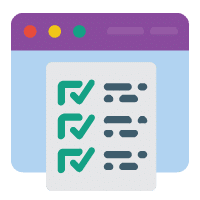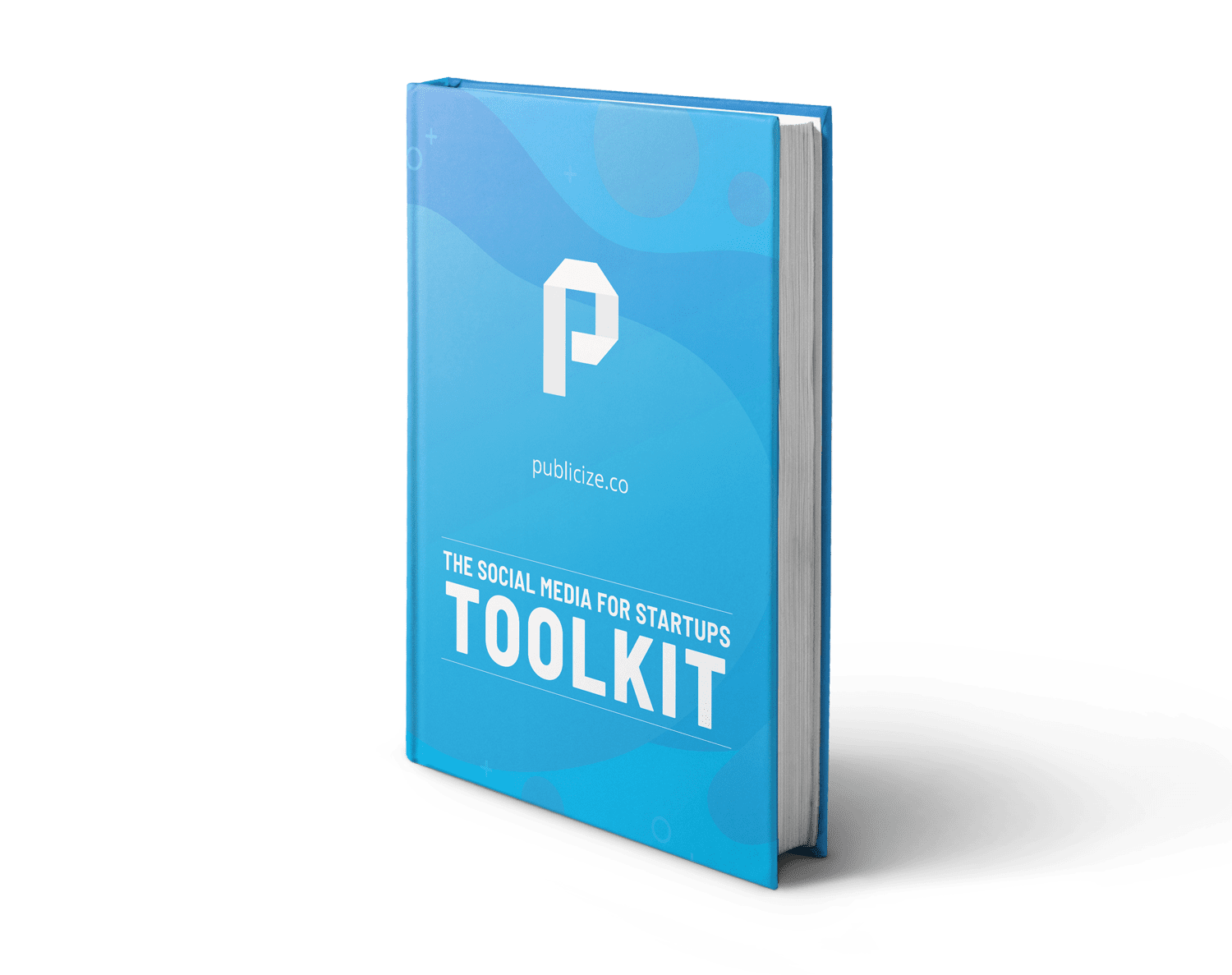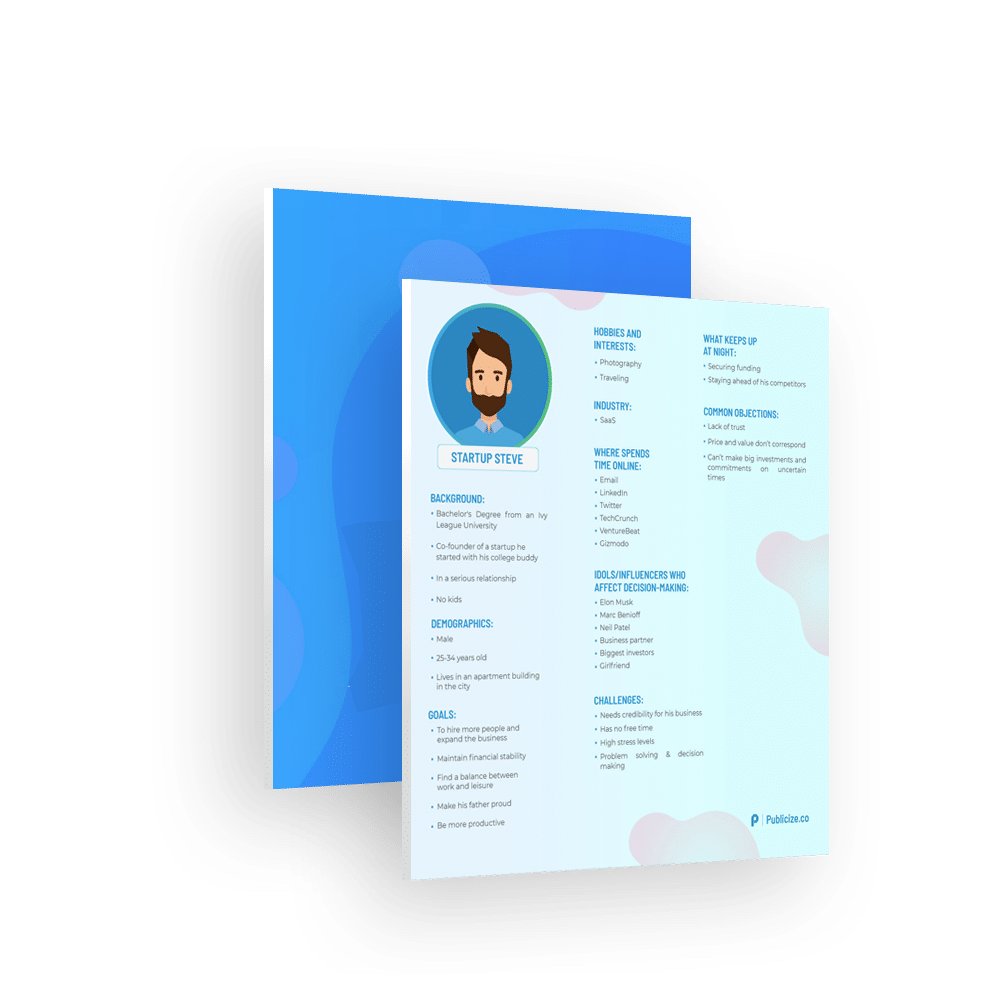Our social media experts have revealed their best social media marketing insights for increasing brand awareness, building audience and boosting conversions through your social channels.
This definitive guide to social media marketing will allow you to create an effective social media strategy, choose the right channels for specific marketing messages and be aware of social media trends for 2021.
Let’s kick things off with a definition.
What is social media marketing?
In a nutshell, social media marketing means using social channels to promote your product or service.
As a tool for developing brand awareness, social media marketing is the vehicle by which businesses foster thought leadership and strong connections with their target audience.
The difference between social media marketing and social media management
Social media marketing and management are often erroneously used as synonyms but there are few key features that set them apart.
Social media marketing focuses on a strategic approach to use social media to grow your business. This is done by leveraging both paid and organic social media.
Social media management, on the other hand, is centered around creating and distributing content on social media platforms and building relationships with the users through interactions such as likes, comments and shares.
Importance of social media marketing
Social media usage trends are some of the most significant in history.
To give some context, there are now over 3.5 billion social media users worldwide who spend nearly 3 hours a day on social platforms.
Likewise, it has revolutionized the way consumers interact with different brands and how brands reach their audience. In fact, 73% of marketers consider their social media marketing efforts to be effective.
Here are some ways your startup or business can benefit from social media:
Fostering relationships with customers
When they’re used effectively, social media platforms teach brands about their audience. Through engagement and follows, businesses are able to better understand the needs and wants of their audience. Using this information to establish a meaningful dialogue between themselves and their customers, businesses begin to build customer trust.
PRO TIP: Research shows that 71% of users who have a good experience with a brand on social media are likely to recommend that company to a friend. However, it’s important to monitor your quality as another study shows that 80% of companies believe they deliver excellent social media customer service, while only 8% of their customers would say the same.
Brand awareness
Social media is the cost-effective way for increasing brand awareness.
According to the rule of seven, customers need to see brands messaging seven times before they purchase from them. With this in mind, social media is incredibly efficient at reaching target audiences several times a week. Social posting, for instance, is purpose-built to make users create content that’s concise. This means that companies can send short and powerful messages to followers for a fraction of the time and cost of organic and paid media.
Generate leads and conversions
The advanced targeting options of social media platforms provide great tools to get your products and services in front of the right users. This creates a lucrative opportunity for generating new leads and boosting conversions. In fact, a survey shows that 76% of consumers purchase products if they’ve seen them on social media.
Increase website traffic
Social media is a great channel to promote your owned media content and attract more traffic to your website. The larger presence you build on social media, the more you can rely on steady social media traffic to your site.
PRO TIP: To increase your social media referral traffic, make sure all your content is easily shareable. Only post when your audience is most active and refine your call-to-actions.
SEO benefits
Even though Google doesn’t suggest that social media is a direct SEO ranking factor, there are strong correlations between the number of social shares and site SEO strength. And of course, the more shares your content has, the more opportunities people have to see and link to it.
What social media marketing platforms should I use?
There are over 200 different social media platforms to date.
While some of the new emerging platforms are generating serious interest, this doesn’t mean you should start marketing on all of them.
When you’re starting out, your best bet is to stick with the biggest platforms. They’ve got the highest number of user, engagement and your prospective clients are more likely to be using them:
Facebook is the largest social media platform with over 2 billion users online, and the largest variety of different demographics.
Even though Facebook is mostly used for B2C marketing, its extremely advanced targeting options and various advertising options also serve many B2B marketers as well.
PRO TIP: Take advantage of Facebook’s advanced targeting options by exploring its “lookalike audiences” that mimic your current audiences. If you already have an audience that is performing well this can be a game-changer as you can just use your formula to create multiple successful audiences.
Facebook shines with its advanced targeting and versatile ad options from messenger ads to native ads. However, you can only benefit from these as long as you pay. Facebook’s algorithms are making it increasingly difficult to succeed with just organic reach.
TechCrunch are brilliant at leveraging Facebook
TechCrunch uses Facebook messenger ads to help users navigate through their social media and website. As messenger ads have higher engagement and better open rates (80%) than general emails (20%), it’s a great way to get in front of your audience.
Instagram is linked to sister platform Facebook allowing you to manage your ads on both platforms at the same time.
Its secret weapon is its engagement rates, which it rises above competing platforms and provides great opportunities for influencer marketing and user generated content (UGC).
PRO TIP: Influencer marketing it’s great way to boost your credibility as 49% of consumers depend on influencer recommendations on social media.
Content that has been created, published by users of a brand (UGC) and influencer marketing help to demonstrate social proof and to build audience trust with your brand. Consumers are more likely to buy Prada sunglasses if Beyoncé’s wearing them, and not me (that’s the tragic reality we’re living in, people), so an endorsement from the influencer account can be a big revenue generator.
Leveraging UGC and influencer marketing is usually associated with B2C, but don’t be discouraged if you’re B2B. For instance, the rise of micro-influencers with a focus on a specific niche market or audience is making big waves for B2B enterprises and reports show a promising 60% higher engagement rate compared to regular campaigns.
Instagram marketing done right with Adobe
Creative software developer Adobe is riding the wave of user generated content and social proof by sharing the work of its most talented product users.
Youtube
According to research, over 50% of consumers want to see videos from brands over any other type of content. And Youtube now being the second largest search engine in the world with users spending over a billion hours watching videos every single day, there’s no better platform for you to answer the consumers’ needs.
PRO TIP: Start creating videos of your products and services. 80% of shoppers who watch a YouTube video related to a purchase they’re planning end up buying.
Video isn’t the most engaging type of content by accident. It’s better at telling stories and grasping our emotions than any other content.
Ok, but what does this have to do with marketing?
Well, research shows that the more you invoke people’s emotions, the looser they become with their spending.
Successful Youtube marketing with P&G
B2C conglomerate P&G expertly appealed to its target audience’s feelings with an empowering video about family and sacrifice. It clearly demonstrates the power of emotional advertising when used properly:
LinkedIn is the home of B2B social media.
Users are not only professionals and businesses, they also have the highest average disposable income of all other social media platforms . Additionally, 80% of all B2B leads acquired from social media come from LinkedIn makes it even more appealing.
But how do you tap into this potential revenue stream?
The LinkedIn ads can target users by company size and location, as well as individual’s title seniority, age, educational background and skill set. This makes it easy to find the right audience. On the other hand LinkedIn ads are more expensive than any other social platform so you need to be strategic with the advertising space that you pay for.
PRO TIP: Use LinkedIn groups for networking with your target audience and establish your expertise. Experiment by using your personal profile to get higher engagement as people are 16 x more likely to read a post from you than from your brand itself.
Moosend’s clever LinkedIn marketing
Moosend uses employees as micro-influencers by asking them to schedule sharing new social media content on their personal accounts. From the CEO to the content creators, Moosend’s workforce works in near unison to push Moosend’s social messaging.
Even though LinkedIn wins on social media B2B lead generation, Twitter comes in at a close second. And not only is it good for leads, Twitter’s also great for networking and showcasing expertise.
With just 280 characters to effectively communicate your message, Twitter drastically improves your writing efficiency.
90% of users read the ad copy and spend more time reading the ads than on any other platform which makes it a promising platform to find your spotlight. As you accomplish to establish an original tone of voice and know how to throw in one or two relevant hashtags to increase the engagement, you’re on the right path.
PRO TIP: Most journalists are on Twitter. Take the time to build relationships with journalists by following and engaging with them before sending out your next pitch and see how you start getting noticed.
Moz knows how to flex its Twitter muscles
The Moz founder Rand Fishkin is a great example of using his twitter for leveraging thought-leadership. His insight on marketing tech and startups are a great way to showcase expertise, increase credibility and add value to his business.
Social media marketing trends 2021
The time to leverage your social media is now or never.
According to a survey, almost 50% of the population spends more time on social media than before due to the pandemic. This means that there are more people in social media than ever, spending more time there than ever.
Although these uncertain times are forcing companies to approach social media marketing in new ways. These are the most important trends to know in 2021:
-Create socially conscious content. Many companies are now expected to take moral, social and even political stances as 56% of consumers say they have no respect for businesses that remain silent on important issues. Companies need to engage more with meaningful content and topics like mental health, inclusivity and social justice. However, it’s imperative to stay authentic. Companies that pretend to have an opinion but are actually just after good PR will get exposed.
-Build trust with user generated content, employee advocacy and influencer marketing. Invest in your employee, customer and influencer relationships to ensure that customers hear positive brand messages from people they can trust.
-Be authentic and transparent. 53% of consumers say they’re likely to buy from brands that are transparent on social, and 86% of Americans say transparency is more important than ever before. Admitting mistakes, giving an honest response to customer queries and showing empathy are some of the best ways to achieve this in 2021.
-Leverage nostalgia marketing. Tapping into the positive cultural memories will be more effective than ever as the world has changed so much in the past year and many are reminiscing the times before pandemic.
-Pay to play. Organic reach continues to decrease. Most social media platforms are making it increasingly difficult to build an organic following so for most brands it’s time to accept that the time to start paying to see results in social media.
How to create a social media strategy
STEP 1. Create a buyer persona and research your audience
Creating a buyer persona is the best way to know your audience. To make it really easy for you, we’ve created a free template including all the steps you need to create one.
STEP 2. Define your social media marketing goals and set clear KPIs
Aligning your social media marketing goals with your business objectives and making them SMART is the key for seeing results with your social media marketing efforts.
STEP 3. Analyze your competition
Social media provides a great opportunity to spy on your competitors and get useful insights into your own strategy. To be able to gather the most accurate analysis, focus on the following in comparison to your own accounts.
- What social media platforms is your competition using?
- Which platforms are they most successful?
- How large is their following and how fast is it growing?
- What are their follower demographics?
- How often are they posting?
- What is their engagement rate?
- What hashtags do they use most often?
- How many hashtags do they use?
- Share of Voice
Once you’ve gathered the information, create a SWOT analysis based on your findings to be able to identify your strengths, weaknesses and opportunities and threats.
PRO TIP: Facebook Analytics feature “Pages to watch” gives you free insights into your competitors Facebook success. You can see the amount of likes, posts, and engagement which will help you to determine the optimal Facebook posting frequency and keep an eye on any new emerging trends.
STEP 4. Choose the right platforms for you and align your profiles
Once a buyer persona has been established and goals have been set, choosing the right platform should be self explanatory. Your target audience may be niche and use a specific platform, but in most cases, the big six I’ve already highlighted previously should be your go-to social channels..
This useful infographic can help you find out where your audience is at:
After choosing the platforms, make sure all your profiles are visually aligned, on-brand and have high quality visuals and accurate company and contact information.
PRO TIP: Once your platforms are polished, consider getting your profiles verified and add links to your social media to your website, newsletters, and email signature.
STEP 5. Create unique and engaging content
Keep in mind that all content you create should be directly related to your goals. Here are some ideas for social media content:
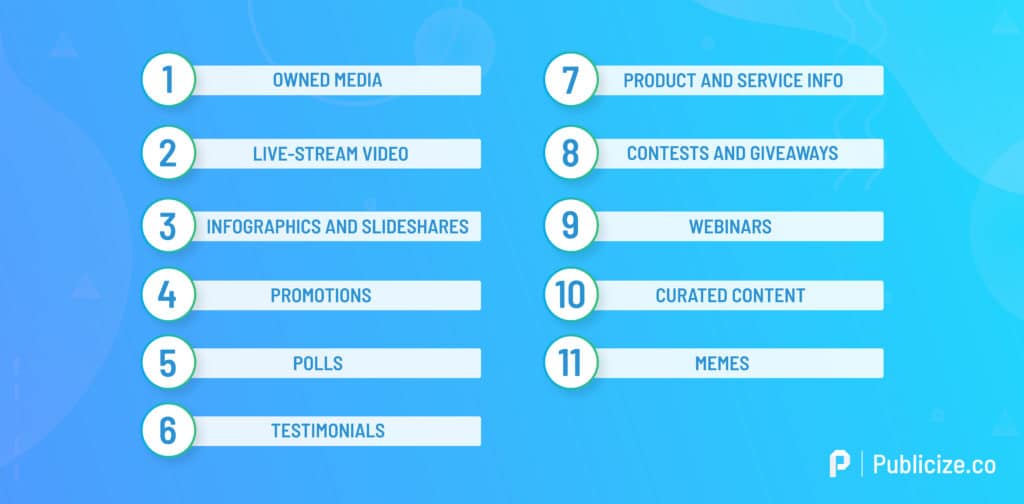
PRO TIP: According to research, users spend longer watching live videos than pre-recorded videos and 79% feel that brings more authentic interaction with the audience.
Don’t forget that you don’t need to always come up with something new. Repurposing old social content with a fresh take is a smart use of time and resources. For example, turning a blog into a social media post or putting eye-catching statistics into an infographic is a great way to rehash old content for social media.
Once you’ve posted, it’s not time to put your feet up. You now need to interact with your audience by commenting, liking and reposting!
PRO TIP: Buying likes might seem like an easier way to look credible than actually going through the trouble of doing it organically. However, these bought likes are often from fake accounts who likely won’t ever engage with your content. Facebook algorithms measure the engagement of your content and if it’s low, your posts will end up never to be seen.
STEP 6. Create a Social Media Content Calendar and start scheduling your posts
Having monthly themes, project deadlines, responsibilities and the content itself all on one document will keep your social media game nice and organized.
In the meantime, do your due diligence when researching the best time to post content. Some days and hours for scheduling posts are more optimal for reaching your target audience. Here’s a little help for you to know when to schedule your posts:
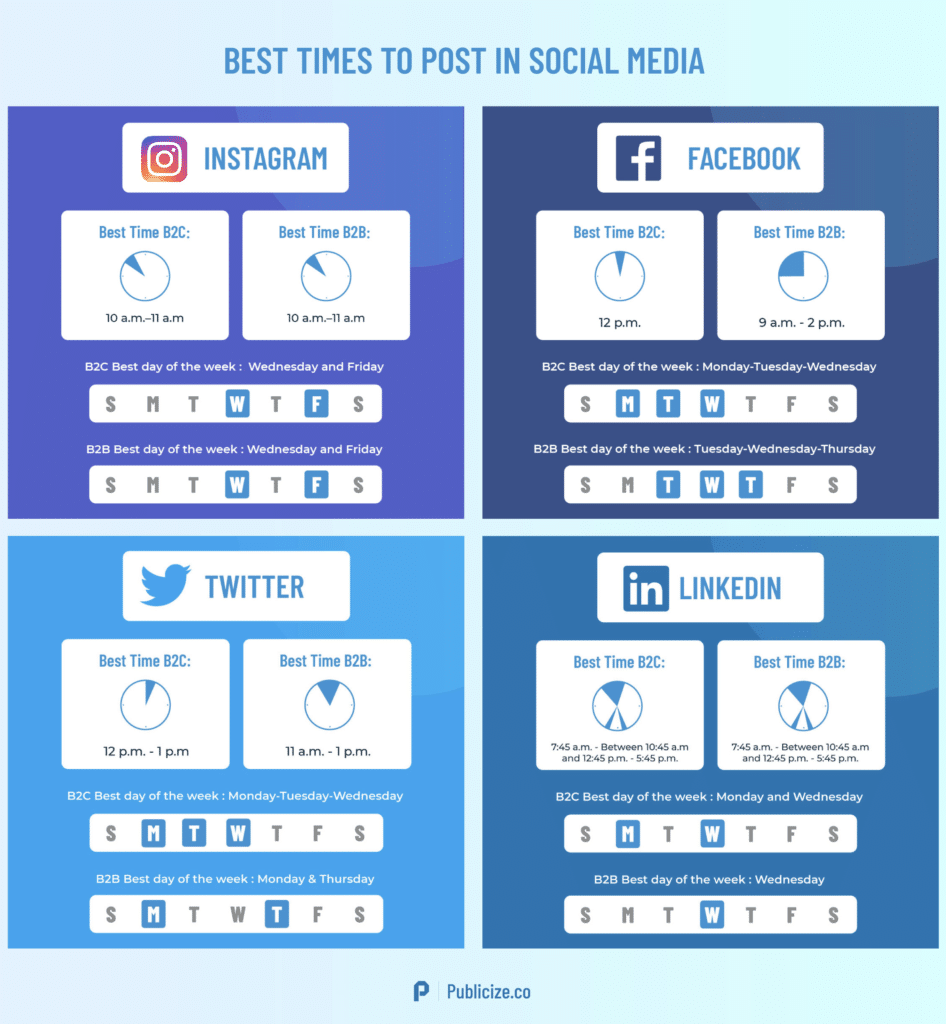
There are various platforms that can help you schedule the posts for you.
The best social media management platforms:
–Hootsuite for all-in-one social media scheduling, monitoring and analytics
–Sendible for all-in-one scheduling and lead generation
–Loomly for those who struggle coming up with post ideas
STEP 7. Start social media advertising
As I’ve already established, you’ll need to adopt a pay to play mentality if you want your social media to have a serious impact on brand awareness and lead generation.
Choosing the right type of ads for each platform is key, as well as knowing the different types of social media ads:
- Influencer Content
- Native ads / Sponsored Content
- Carousel/Collection Ads
- Display Ads
- Messenger/Sponsored InMail Ads
PRO TIP: Influencer marketing it’s great way to boost your credibility as 49% of consumers depend on influencer recommendations on social media.
STEP 8. Measure your results
Once you get your content out there and ads running you need to make sure you keep a close eye on the metrics.
Make sure to measure month on month and compare the two time periods so you know if you’re growing or dropping. You need to know which pieces of content are generating the most engagement and traffic so you can capitalize on that or learn from it.
These are some important social media marketing metrics to look at:
-Impressions: How many times your content is displayed, no matter if it was clicked or not.
-Engagement: Engagement rate, number of comments, likes, reposts & shares
-Referral traffic: How many people visited your website through social media
-CTR: The ratio between impressions and clicks
-SQL: The number of sales qualified leads that came from social media
-Conversions: How many of these leads converted
Wrapping up
Now you should have a clear idea of what social media platforms to choose, how to create a social media marketing strategy and what trends to leverage in 2021.
To make your social media successful is simple if you follow these steps, although – I’m not gonna lie – it requires a lot of time and constant effort.
As we know that’s a luxury which not every company has, our team of Social Media experts are always willing to help.
Otherwise, you can always come back to this guide or deepen your knowledge about Social Media PR, Social Media Strategy for Startups and Digital Advertising.





